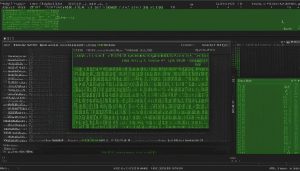Gentoo Linux is a specialized distribution that caters to technically minded individuals. Unlike other distributions, Gentoo requires manual installation and configuration, following the guidelines provided in the Gentoo Handbook. It is not recommended for beginners or those seeking a quick and easy setup. Gentoo is designed for users who are willing to invest time and effort into learning the intricacies of the system. It offers a powerful and flexible environment, but this comes with a learning curve that may not be suitable for all users. The Gentoo community is known for its helpfulness and support, provided that users follow the official installation procedures outlined in the Handbook.
Key Takeaways:
- Gentoo Linux is a specialized distribution for technically minded individuals.
- Manual installation and configuration are required, following the Gentoo Handbook.
- It offers a powerful and flexible environment but has a steep learning curve.
- The Gentoo community provides helpful support when users follow official installation procedures.
- Gentoo Linux may not be suitable for beginners or those looking for a quick and easy setup.
The Importance of the Gentoo Handbook
The Gentoo Handbook is a vital resource for anyone looking to install and use Gentoo Linux. It not only provides step-by-step instructions for the installation process but also serves as a comprehensive documentation guide for the entire system. Following the guidelines outlined in the Handbook ensures a reliable and up-to-date installation, allowing users to start their Gentoo journey on the right foot.
“The Gentoo Handbook is an invaluable tool for Gentoo Linux users. It provides clear and concise instructions, making the installation process straightforward, even for newcomers. Plus, the Handbook also serves as an excellent resource for learning the fundamentals of Gentoo.”
Deviation from the official installation process, such as using installer scripts or alternative guides, is not recommended. Doing so may lead to disadvantages and hinder support from the Gentoo community. By following the official Handbook, users can ensure that their Gentoo installation is stable, well-documented, and compatible with the extensive range of software available.
| Gentoo Handbook Advantages | Gentoo Handbook Recommendations |
|---|---|
|
|
Whether you are a seasoned Linux user or just starting your journey, the Gentoo Handbook is an essential companion. It provides the knowledge and guidance needed to successfully install and use Gentoo Linux, ensuring a smooth and rewarding experience.
Resources:
[1] Gentoo Handbook Official Documentation
The Learning Curve of Gentoo Linux
Gentoo Linux is known for its steep learning curve, which sets it apart from other distributions. The installation process requires more time and effort compared to other operating systems, making it more suitable for technically minded individuals who are willing to invest in learning the system. New users may find the initial installation process to be time-consuming, especially as they familiarize themselves with the various configuration settings and options.
However, the time spent on installation is not in vain, as it serves as an investment in learning. Gentoo Linux aims to educate users on the intricacies of the system, allowing them to gain a deeper understanding of how the operating system works. As users become more proficient and knowledgeable, the installation process becomes faster and simpler.
It is important to note that Gentoo Linux has specific system requirements that may not be suitable for all users. The distribution demands a certain level of technical expertise and a willingness to delve into the inner workings of the system. Users who are not interested in investing time and effort into learning the system may find other, more user-friendly distributions to be a better fit for their needs.
The Power of Portage Package Manager
Gentoo Linux stands out from other distributions because of its powerful Portage package manager. Portage is a source-based package manager that offers extensive customization options and precise control over software installation. With Portage, users can build packages from source code during installation, allowing them to optimize their system and tailor it to their specific needs.
One of the key features of Portage is its support for USE flags. USE flags enable users to enable or disable certain dependencies for packages, giving them even more control over their system. For example, if a user doesn’t need support for a specific feature in a package, they can disable the corresponding USE flag, reducing unnecessary dependencies. This level of granularity in package customization sets Gentoo apart from other distributions.
Additionally, Portage is supported by a vast repository of packages in the main Gentoo repository. This means that users have access to a wide range of software that can be easily installed and managed through Portage. The Gentoo community also maintains overlays, user-maintained repositories that provide additional packages not available in the main repository. This further expands the software availability and customization options for Gentoo users.
| Advantages of Portage Package Manager | Disadvantages of Portage Package Manager |
|---|---|
|
|
“Portage, with its source-based package management and customization options, is a powerful tool for developers and enthusiasts who want full control over their system. It allows me to optimize my system and choose exactly which software I want to install. However, the longer compile times for certain packages can be a drawback, especially for users with limited time or older hardware. Overall, Portage is one of the standout features of Gentoo Linux and a key reason why I continue to use this distribution.”
Gentoo Linux Overlays and Customization
Gentoo Linux offers a unique feature called overlays that allows users to expand the software availability beyond the main Gentoo repository. Overlays are unofficial and user-maintained repositories of ebuilds, which are package descriptions. These overlays provide access to additional packages that may not be included in the official repository, offering users more options for customization and package availability. They are particularly useful for accessing niche or specialized software that might cater to specific needs or preferences.
Using overlays in Gentoo Linux can enhance the overall experience by providing a wider range of software choices. However, it’s important to note that overlays require careful management of dependencies and compatibility issues. It’s advisable to thoroughly test and verify the compatibility of packages from overlays to ensure a stable and reliable system.
To manage overlays in Gentoo Linux, the package manager Portage provides the necessary functionality. Portage allows users to add, remove, and prioritize overlays, ensuring smooth integration of additional packages into the system. By leveraging overlays and the power of Portage, Gentoo Linux users can tailor their systems to their specific needs, creating a highly customized environment that aligns with their preferences.
Benefits of Overlays and Customization
- Expanded software availability: Overlays provide access to a wider range of packages that might not be available in the main Gentoo repository.
- Specialized software options: By using overlays, users can access niche or specialized software that caters to specific needs or preferences.
- Customization possibilities: Gentoo Linux, combined with overlays, offers extensive customization options, allowing users to tailor their systems to their specific requirements.
Challenges and Considerations
- Dependency and compatibility management: When using overlays, it’s crucial to carefully manage dependencies and ensure compatibility with the existing system to avoid potential conflicts or instability.
- Testing and verification: Before integrating packages from overlays into the system, thorough testing and verification are recommended to ensure the stability and reliability of the overall system.
- User support and documentation: Overlays may have varying levels of community support and documentation compared to the main Gentoo repository. Users should be prepared to rely on their own troubleshooting skills or seek assistance from the overlay maintainers if needed.
Gentoo Linux overlays provide a valuable tool for customization and expanding software availability. By leveraging overlays and the power of Portage, users can create highly tailored systems that cater to their specific needs and preferences. However, it’s important to approach overlays with caution and ensure proper management of dependencies and compatibility. With careful consideration and testing, overlays can enhance the Gentoo Linux experience and provide access to a wider range of software options.
Benefits and Drawbacks of Gentoo Linux
Gentoo Linux offers several benefits that make it an attractive choice for technically minded individuals. One of the key advantages is the powerful and flexible environment that Gentoo provides. With Gentoo, users have the ability to customize their system to a high degree, allowing for optimal performance and a tailored computing experience. This level of customization is particularly beneficial for developers and enthusiasts who want precise control over their software environment.
Another advantage of Gentoo Linux is the supportive community that surrounds it. The Gentoo community is known for its helpfulness and willingness to assist users who follow the official installation procedures outlined in the Gentoo Handbook. This support can be invaluable, especially for those who are new to Gentoo and may encounter challenges along the way. The community provides a wealth of knowledge and resources to help users navigate the learning curve associated with Gentoo Linux.
However, it’s important to note that Gentoo Linux also has its drawbacks. One of the main drawbacks is the longer compile times for certain packages. Due to Gentoo’s source-based package management system, packages are built from source code during installation, which can be time-consuming. This longer compile time may not be suitable for users who prioritize quick software installation and updates.
“Gentoo Linux offers a powerful and customizable environment that allows users to tailor their system to their specific needs. The supportive community is a great resource, providing assistance and guidance throughout the learning process. However, the longer compile times may deter some users who value quicker software installation and updates.”
Additionally, the availability of specific packages may be limited in Gentoo Linux. While the main Gentoo repository offers a wide range of software, there may be niche or specialized packages that are not included. To address this, Gentoo supports overlays, which are unofficial repositories maintained by users. These overlays add additional packages to the system, giving users more options for customization. However, managing overlays and ensuring compatibility with the main repository can require additional effort and may not always be straightforward.
Table: Benefits and Drawbacks of Gentoo Linux
| Benefits | Drawbacks |
|---|---|
| Powerful and flexible environment | Longer compile times for certain packages |
| Extensive customization options | Limited availability of specific packages |
| Supportive Gentoo community | Additional effort required for managing overlays |
In summary, Gentoo Linux provides a powerful and customizable environment for technically minded individuals. The flexibility, extensive customization options, and supportive community make it an appealing choice. However, the longer compile times and potential challenges in finding specific packages may not suit all users. It is essential for users to consider their priorities and technical requirements before deciding if Gentoo Linux is the right fit for their needs.
Gentoo Linux: My Personal Experience and Recommendations
As someone who enjoys diving deep into the world of Linux, my personal experience with Gentoo Linux has been both challenging and rewarding. The installation process, although time-consuming, allowed me to truly understand the inner workings of the system. I followed the Gentoo Handbook step-by-step, which provided detailed instructions and ensured a reliable installation.
One aspect that stood out to me was the power of the Portage package manager. Compiling packages from source code not only gave me full control over my system’s optimization, but it also allowed me to customize each package to my specific needs. The extensive availability of USE flags further enhanced the flexibility of Gentoo. I was able to enable or disable specific package features, tailoring my system precisely to my requirements.
Engaging with the Gentoo community has been a highlight of my Gentoo Linux journey. Their helpfulness and support, as long as I followed the official installation procedures outlined in the Gentoo Handbook, made troubleshooting and learning from others a breeze. However, it’s worth mentioning that the learning curve of Gentoo can be steep, especially for those new to Linux. It requires dedication, patience, and a willingness to invest time and effort into understanding the system.
My Recommendations for Gentoo Linux
- Allocate enough time: Installing and configuring Gentoo Linux takes time, so be prepared to invest a significant amount of hours into the process.
- Stick to the Gentoo Handbook: Deviating from the official installation process may hinder your ability to receive support from the community. Following the Handbook ensures a reliable and up-to-date installation.
- Read and learn: Gentoo Linux offers extensive documentation and resources. Take advantage of them to expand your knowledge and fully grasp the intricacies of the system.
In conclusion, Gentoo Linux is an excellent choice for those who want to delve deep into the world of Linux and have the time and dedication to invest in learning the system. Its powerful environment, customizable package management, and supportive community make it a rewarding experience for enthusiasts. However, for those seeking a quick and easy setup or who are new to Linux, other distributions may be more suitable. Overall, my personal experience with Gentoo Linux has been enlightening, and I would recommend it to individuals who are eager to explore and customize their Linux environment.
Conclusion
In conclusion, Gentoo Linux is a specialized distribution that offers a powerful and flexible environment for technically minded individuals. It requires a manual installation process and has a steep learning curve. The Gentoo Handbook serves as the official installation guide and provides essential knowledge for users. Portage, the package manager used in Gentoo, offers extensive customization options and precise control over software installation. However, Gentoo has its drawbacks, including longer compile times and potential challenges in finding specific packages.
Personal experiences with Gentoo may vary, but overall, it is a rewarding experience for those who are willing to invest the time and effort into learning the system. I recommend Gentoo Linux for users who have some free time and are comfortable with reading and following documentation. While it may not be suitable for everyone, Gentoo offers a unique and customizable Linux environment that can be tailored to individual needs and preferences.
Final thoughts on Gentoo Linux are that it is a distribution that requires dedication and a willingness to learn, but the rewards are worth it. The power and flexibility it offers, along with the supportive community and extensive documentation, make it a valuable choice for technically minded users. However, it is important to consider the longer compile times and potential challenges in finding specific packages before deciding if Gentoo is the right distribution for you. Overall, Gentoo Linux is a distinctive and rewarding experience for those who want to delve deeper into the inner workings of a Linux system.
FAQ
What is Gentoo Linux?
Gentoo Linux is a specialized distribution that is geared towards technically minded individuals.
How is Gentoo Linux installed?
Gentoo Linux requires manual installation and configuration, following the guidelines provided in the Gentoo Handbook.
Is Gentoo Linux suitable for beginners?
Gentoo Linux is not recommended for beginners or those looking for a quick and easy setup.
What is the Gentoo Handbook?
The Gentoo Handbook serves as the official installation guide for Gentoo Linux.
What is Portage?
Portage is the package manager used in Gentoo Linux, allowing for greater customization options and control over software installation.
What are overlays in Gentoo Linux?
Overlays are unofficial and user-maintained repositories of ebuilds that allow users to access niche or specialized software.
What are the advantages of using Gentoo Linux?
Gentoo Linux offers a powerful and flexible environment, extensive customization options, and a supportive community.
What are the drawbacks of using Gentoo Linux?
Gentoo Linux has longer compile times for certain packages and potential challenges in finding specific software.
What is the learning curve of Gentoo Linux?
Gentoo Linux has a steep learning curve and requires an investment of time and effort to learn the system.
What is the author’s personal experience with Gentoo Linux?
The author shares their positive experiences with the Gentoo documentation, Portage package manager, and the Gentoo community.
Would the author recommend Gentoo Linux?
The author recommends Gentoo Linux for users who have some free time and are comfortable with reading and following documentation.
Hi, I’m Mark, the author of Clever IT Solutions: Mastering Technology for Success. I am passionate about empowering individuals to navigate the ever-changing world of information technology. With years of experience in the industry, I have honed my skills and knowledge to share with you. At Clever IT Solutions, we are dedicated to teaching you how to tackle any IT challenge, helping you stay ahead in today’s digital world. From troubleshooting common issues to mastering complex technologies, I am here to guide you every step of the way. Join me on this journey as we unlock the secrets to IT success.


